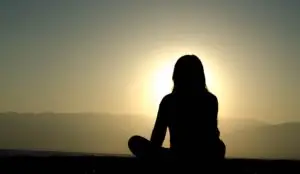SOFTENING
The Seven Gestures
Gently Tuning Into Relaxation and Letting Go
The Seven Gestures posture is a balanced way of sitting that allows energy to circulate well through the body. This posture is so effective in promoting relaxation, balance, and integration that it can be used as a complete practice in itself.
1. Select a cushion that is firm and of a comfortable height, thick enough to raise the pelvis above the level of the knees. Sit with your legs crossed, with one leg in front of the other, or, if you prefer, in the half or full lotus. You may also sit with one knee raised and the foot of that leg flat on the floor, or in a straight-backed chair, with both feet flat on the floor and about twelve inches apart. A low meditation bench that allows your legs to be under you will also work well. In all of these variations, the triangle formed by the three points—buttocks and knees—is your essential foundation.
Make yourself comfortable on your seat. Take a few moments to relax and let your limbs ease into place. Experience the sensations in your lower body, such as those where your feet, legs, and pelvis are in contact with the cushion, chair, or bench. In time a sense of being grounded may arise—a firm base for practice.
If you cannot sit on the floor, use a straight-backed chair, and sit with both feet on the ground, a comfortable distance apart.
2. With hands on knees (or as far in that direction as they naturally reach), palms down, release tension in the shoulders, and feel the weight of your shoulders and arms as they settle downward. Sense the points of contact between knees or thighs and hands.
3. It is most important that the back is straight and balanced from the base of the spine to the base of the neck so that energy can travel freely from the lower into the upper body. If your back becomes tired, make certain that the top of your pelvis is tilted slightly forward, so that your lower back retains its natural forward curve. Tune in to the sensations in your back and along your spine. Draw the shoulders back a little. Lift the chest slightly and soften the tension in the shoulders.
4. Tuck your chin a bit toward your neck, so that the back of the neck is aligned with the spine, and the head balances easily on top of the spinal column without tensing the neck muscles.
5. The mouth is slightly open, with the lips about a half inch apart. This relieves tension in the jaw muscles and allows breath to flow freely, through nose and mouth equally. While it may take a little practice to get accustomed to this way of breathing, it is important to balance the breath by allowing it to flow through both nose and mouth. Breathing through the nose stimulates the head and thoughts, while mouth breathing awakens the body. Breathing through both together helps to gently balance and integrate the body and mind, the head and heart.
6. The tip of the tongue is lightly touching the ridge of the palate, just behind the front teeth. The tip of the tongue is slightly curled back, and the tongue is relaxed.
7. The eyes are open with a soft, panoramic gaze. Notice muscle tension around the eyes and let it melt away. You can minimize the need to blink by relaxing the area around your eyes and drawing your awareness inward. This happens naturally when you soften the focus of your eyes and imagine you are looking inward, toward the back of the eyeballs.
It can take several weeks for your body to relax fully into this position. It is important to remind yourself that with practice, small discomforts will soon ease, allowing you to sit comfortably for longer periods of time. It is not necessary to struggle to create a sense of stability. If you start with the body comfortable and the back straight, your body will develop its own points of balance. You may sense small shifts from time to time; this is perfectly normal, and you can enjoy the subtle feelings that often accompany these shifts.
Listen to your body for guidance on how to explore experience in a new way, not necessarily with words, but in movement.
Each sensation or feeling or sound or thought is its own gesture.
Each of these feeling-gestures can be the seed of fresh experience.
Source- The Joy of Being, by Tarthang Tulku